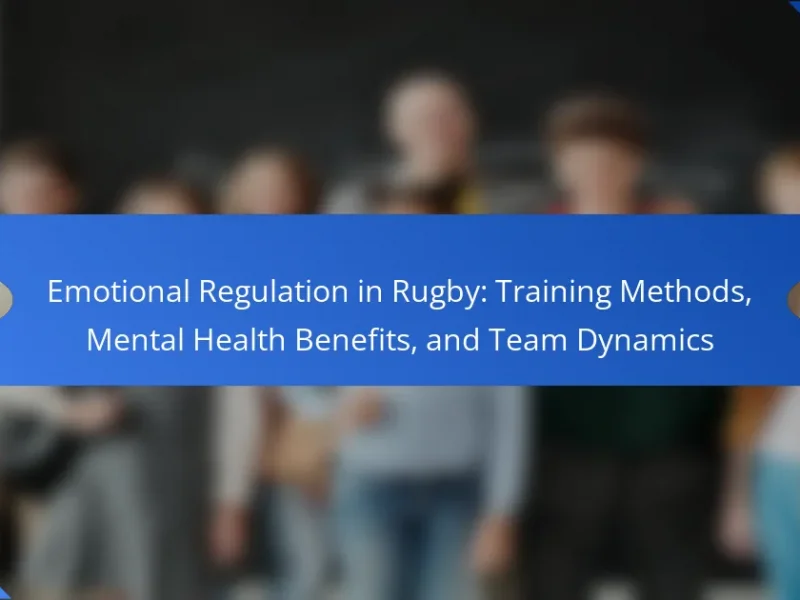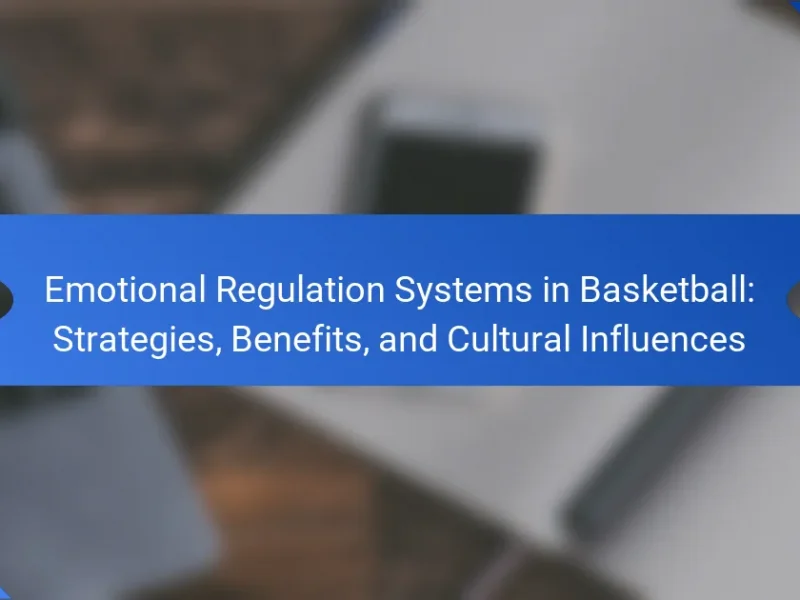Cultural perspectives on emotional regulation in soccer significantly impact player performance and team dynamics. This article explores various emotional control techniques across cultures, highlights the challenges players face, and showcases success stories from diverse backgrounds. Understanding these cultural influences can enhance coaching strategies and improve player development in the sport.

What are the cultural perspectives on emotional regulation in soccer?
Cultural perspectives on emotional regulation in soccer vary widely, influencing players’ performance and team dynamics. Different cultures emphasize distinct emotional control techniques, such as mindfulness in Japan and expressive communication in Brazil.
In many European countries, emotional regulation is often linked to tactical discipline, where maintaining composure during high-pressure situations is crucial. For instance, German soccer prioritizes mental resilience, fostering a culture that values emotional stability.
Challenges arise from cultural expectations; in some regions, displaying emotions may be seen as a weakness, while in others, it is encouraged. Success stories include teams that have integrated emotional intelligence training, leading to improved cohesion and performance.
Ultimately, understanding these cultural perspectives can enhance coaching strategies and player development, fostering a more holistic approach to soccer.
How do different cultures perceive emotional regulation in sports?
Different cultures perceive emotional regulation in soccer uniquely, influenced by social norms and values. For instance, in Brazilian culture, emotional expression is often celebrated, fostering creativity on the field. Conversely, Japanese players may emphasize restraint, focusing on discipline and teamwork. Techniques vary, with some cultures promoting mindfulness practices, while others rely on traditional rituals. Challenges arise when players face conflicting expectations, leading to stress. Success stories highlight athletes who blend cultural insights, enhancing performance and emotional resilience.
What role does emotional regulation play in soccer performance?
Emotional regulation significantly enhances soccer performance by improving focus and resilience. Players who effectively manage their emotions can maintain composure under pressure, leading to better decision-making during games. Techniques such as mindfulness and visualization are commonly adopted across cultures to bolster emotional control. For instance, studies show that athletes practicing these techniques report higher confidence levels and reduced anxiety, contributing to more consistent performance outcomes. Cultural perspectives reveal that emotional regulation strategies can vary, with some regions emphasizing collective emotional support, while others focus on individual mental training. Success stories from diverse soccer programs highlight the transformative impact of emotional regulation on player development and team dynamics.

What are the universal techniques for emotional regulation used in soccer?
Universal techniques for emotional regulation in soccer include mindfulness, visualization, and controlled breathing. These methods help players manage stress, maintain focus, and enhance performance.
Mindfulness encourages players to stay present, reducing anxiety during high-pressure situations. Visualization allows athletes to mentally rehearse successful plays, boosting confidence. Controlled breathing techniques help regulate physiological responses, calming nerves before and during games.
Cultural differences influence the adoption and effectiveness of these techniques. For example, teams from collectivist cultures may emphasize group-based emotional support, while individualistic cultures might focus on personal strategies. Success stories often highlight athletes who effectively use these techniques to overcome challenges, demonstrating their universal applicability in the sport.
How do players manage stress during high-pressure matches?
Players manage stress during high-pressure matches through various cultural techniques, including mindfulness practices and team cohesion strategies. These methods help athletes maintain focus and emotional balance. For instance, players from different cultures may use breathing exercises or visualization techniques to cope with anxiety. Additionally, strong support systems within teams can enhance emotional regulation. Cultural differences can influence the effectiveness of these techniques, making it crucial for players to adopt practices that resonate with their backgrounds.
What strategies are commonly employed by coaches to enhance emotional control?
Coaches commonly employ strategies such as mindfulness training, visualization techniques, and emotional intelligence development to enhance emotional control. These methods help athletes manage stress, improve focus, and maintain composure during high-pressure situations. For example, mindfulness practices encourage players to stay present, reducing anxiety and enhancing performance. Visualization allows athletes to mentally rehearse scenarios, boosting confidence and emotional resilience. Emotional intelligence training fosters better self-awareness and interpersonal skills, enabling players to navigate the emotional dynamics of the game effectively.
What are the steps in developing a pre-game emotional regulation routine?
Developing a pre-game emotional regulation routine involves several key steps.
1. **Self-Assessment**: Identify personal emotional triggers and responses to game situations.
2. **Goal Setting**: Establish clear emotional goals for performance, such as maintaining composure under pressure.
3. **Breathing Techniques**: Implement deep breathing exercises to promote relaxation and focus.
4. **Visualization**: Use mental imagery to envision successful performances and manage anxiety.
5. **Routine Development**: Create a consistent pre-game routine that incorporates these techniques to enhance emotional stability.
6. **Reflection**: After games, evaluate emotional responses to improve future routines.
How can visualization techniques aid in emotional regulation?
Visualization techniques can significantly enhance emotional regulation by providing athletes with mental strategies to manage emotions during high-pressure situations. These techniques help players visualize successful performances, thus reducing anxiety and increasing focus.
In soccer, cultural perspectives influence how visualization is applied. For example, teams from different regions may emphasize various visualization techniques based on local beliefs about mental preparation. Success stories abound where athletes credit visualization for improved emotional stability, leading to better performance outcomes.
Research shows that athletes who regularly practice visualization report lower stress levels and greater emotional control during matches. This highlights the unique attribute of visualization as a tool that transcends cultural boundaries, offering universal benefits in emotional regulation.

What unique emotional regulation techniques are found in specific cultures?
Cultural perspectives on emotional regulation in soccer highlight unique techniques that vary globally. For instance, Brazilian players often utilize music and dance to express emotions, enhancing team cohesion. In contrast, Japanese players emphasize mindfulness and meditation, fostering focus and resilience under pressure. These culturally specific techniques address emotional challenges and contribute to success stories in soccer.
How do Latin American players approach emotional expression on the field?
Latin American players often embrace emotional expression on the field as a vital aspect of their gameplay. This approach reflects cultural values that prioritize passion and intensity in soccer. Techniques such as celebrating goals with exuberance and expressing frustration openly are common. Challenges include balancing emotional expression with discipline to avoid penalties. Success stories highlight players who channel their emotions positively, enhancing team dynamics and fan engagement.
What are the unique practices of European teams in managing player emotions?
European teams uniquely manage player emotions through tailored psychological support, cultural sensitivity, and collaborative team dynamics. Techniques include employing sports psychologists, fostering open communication, and integrating mindfulness practices. These approaches address challenges like performance anxiety and emotional burnout, leading to success stories such as improved player resilience and team cohesion.

What are the rare emotional regulation challenges faced by players?
Players face unique emotional regulation challenges influenced by cultural contexts. Rarely, these challenges include the pressure to conform to national expectations, which can lead to anxiety and stress. Additionally, cultural stigma surrounding mental health may prevent players from seeking help. In some cultures, expressing emotions is discouraged, complicating emotional expression during matches. Furthermore, varying cultural interpretations of success can create internal conflicts, impacting performance. Understanding these rare challenges is crucial for developing effective emotional regulation techniques tailored to diverse backgrounds.
How do cultural stigmas affect emotional expression in soccer?
Cultural stigmas significantly hinder emotional expression in soccer by enforcing rigid norms. Players often suppress feelings to conform to expectations of toughness and composure. This suppression can lead to stress and hinder performance. For example, cultures that prioritize stoicism may discourage athletes from openly displaying emotions, impacting team dynamics and personal well-being.
What are the challenges of emotional regulation in youth soccer programs?
Youth soccer programs face significant challenges in emotional regulation, including cultural differences, pressure to perform, and inadequate support systems. Cultural perspectives can influence how emotions are expressed and managed. For instance, some cultures may emphasize resilience, while others might prioritize emotional expression. Additionally, the pressure to succeed can lead to anxiety and stress, making emotional regulation more difficult. Programs often lack trained staff to provide emotional support, which can exacerbate these challenges. As a result, fostering an environment that promotes healthy emotional regulation is crucial for the development of young athletes.

What success stories highlight effective emotional regulation in soccer?
Effective emotional regulation in soccer is exemplified by players like Cristiano Ronaldo and coaches like Pep Guardiola. Ronaldo’s ability to maintain composure under pressure has led to numerous game-winning performances. Guardiola emphasizes emotional intelligence in team dynamics, fostering resilience and focus. These examples illustrate how emotional regulation enhances performance and teamwork in soccer.
What case studies exemplify successful emotional management in teams?
Successful emotional management in teams is exemplified by various case studies in soccer. One notable example is FC Barcelona, known for its emphasis on emotional regulation through team-building activities and mental conditioning. These practices foster a supportive environment, enhancing player collaboration and performance. Another case is the German national team during the 2014 World Cup, where emotional resilience was cultivated through workshops and team bonding, leading to their ultimate victory. Lastly, the approach of the Dutch national team in the 2010 World Cup, focusing on open communication and conflict resolution, significantly improved team dynamics and emotional stability.
How have individual players overcome emotional challenges to achieve success?
Individual players have utilized various emotional regulation techniques to overcome challenges and achieve success in soccer. Techniques such as mindfulness, visualization, and positive self-talk have been instrumental. For instance, players from different cultural backgrounds often adapt these methods to align with their personal experiences, enhancing their resilience.
Notable success stories include players who faced significant adversity, such as injuries or personal losses, yet managed to refocus their emotional energy towards performance. These narratives often highlight the unique attributes of cultural perspectives on emotional regulation, showcasing how diverse backgrounds influence coping strategies.
As a result, emotional resilience becomes a key factor in achieving success on the field, demonstrating that overcoming emotional challenges is not only possible but can lead to remarkable accomplishments.

What best practices can enhance emotional regulation for soccer players?
Practicing mindfulness techniques can significantly enhance emotional regulation for soccer players. Techniques such as deep breathing, visualization, and positive self-talk help manage stress and maintain focus during games. Cultural perspectives highlight how different regions emphasize emotional resilience, with success stories showcasing players who effectively use these practices to overcome challenges.
What are the most effective tips for players to improve emotional resilience?
To improve emotional resilience, players can adopt techniques such as mindfulness, positive self-talk, and visualization. These strategies help manage stress and enhance performance. Cultural perspectives highlight the importance of community support and shared experiences in fostering resilience. Success stories from diverse backgrounds demonstrate that emotional regulation can be cultivated through practice and dedication.
What common mistakes should players avoid in emotional regulation?
Players should avoid overreacting to mistakes, suppressing emotions, and neglecting communication. These common pitfalls hinder emotional regulation and affect performance. Recognizing triggers and practicing mindfulness can enhance emotional control. Additionally, fostering a supportive team environment promotes healthier emotional expression.


